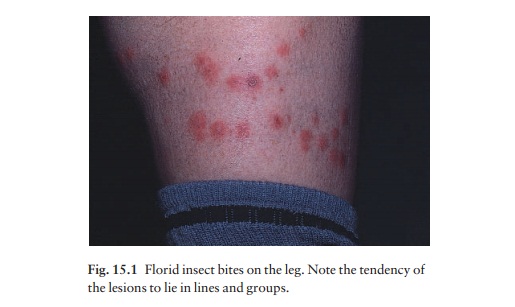Chapter: Clinical Dermatology: Infestations
Papular urticaria

Papular
urticaria
Cause
This term, with its hint that the condition is a variant of ordinary urticaria, is a misnomer. Papular urticaria is nothing more than an excessive, possibly allergic, reaction to insect bites. The source of the bites may be simple garden pests but more often is a parasite on a domestic pet. Human fleas are now rather uncommon. Often the source cannot be traced.
Presentation
Lesions
are usually most common on the arms or legs. They consist of groups or lines of
small itchy excoriated smooth urticarial papules (Fig. 15.1) of a uniform size
that may become bullous and infected. Some clear to leave small scars or
pigmented areas.

Course
Lesions
tend to start after infancy, and an affected child will usually ‘grow out’ of
the problem in a few years, even if the source of the bites is not dealt with.
Individual lesions last for 1 or 2 weeks and recur in distinct crops,
especially in the summerahence the lay term ‘heat bumps’. The lesions will
disappear with any change of environment, for example by going on holiday.
Surprisingly often only one member of a family is affected, perhaps because the
others have developed immunological tolerance after repeated bites.
Complications
Itching
leads to much discomfort and loss of sleep.
Impetiginization
is common.
Differential diagnosis
The
grouped excoriated papules of papular urticaria are quite different from the
skin changes of scabies, in which burrows are the diagnostic feature. Atopic
prurigo may be more difficult to distinguish but here there is usually a family
history of atopy and frankly eczematous plaques are found in a typical
distribution.
Investigations
The
parents should be encouraged to act as detectives in their own environment, but
some resist the idea that the lesions are caused by bites, asking why the other
family members are not affected. This attitude is often supported by
veterinarians who, after a superficial look at infested animals, pronounce them
clear. In such cases the animal should be brushed vigorously while standing on
a polythene sheet. Enough dandruff-like material can then be obtained to send
to a reliable veterinary laboratory. Often the cause is a Cheyletiella
mite infestation.
Treatment
Local
treatment with Eurax HC ointment or calamine lotion, and the regular use of
insect repellents, may be of some help but the ultimate solution is to trace
the source of the bites.
Infested
animals should be treated by a veterinar-ian, and insecticidal powders should
be used for soft furnishings in the home. Sometimes professional exterminators
are needed; but even measures such as these can meet with little success.
Related Topics